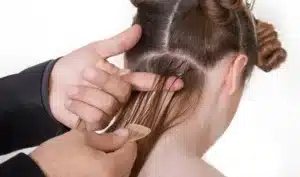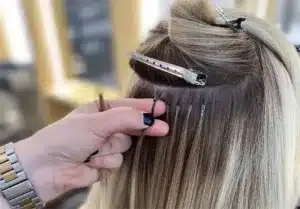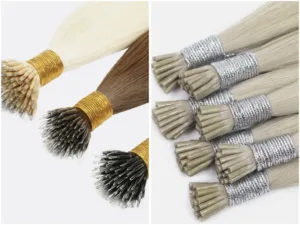Sticky residue, tangles, and dull ends happen when wash routines are wrong. Clients feel it fast. Bonds loosen. Color fades. You can avoid this with clear steps, right products, and strict drying at the base.
Yes, you can wash human hair extensions. Temporary sets (clip-ins, halo) come off and soak. Installed sets (weft rows, tape-ins, keratin/fusion, i-tip/nano) wash on the head with vertical motions, sulfate-free shampoo, conditioner on lengths only, and full base drying to prevent slippage and odor.
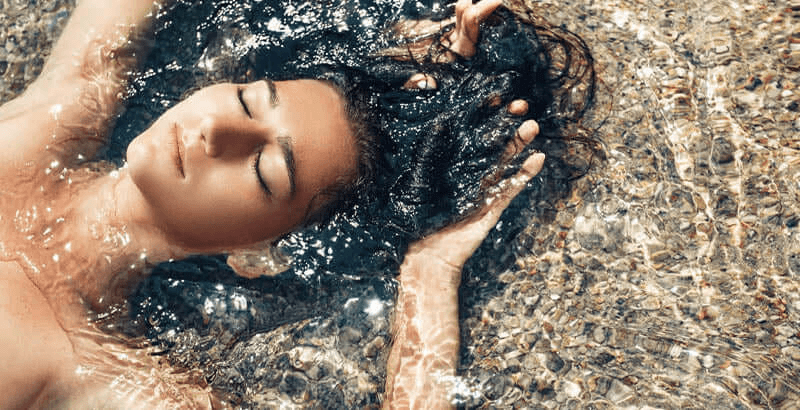
This guide breaks washing by attachment type, hair grade, and lifestyle. You get exact steps, time markers, and ingredient rules that keep the cuticle tight and the seams secure. Use it for client education and team training.
Can you wash hair extensions?
Some say “don’t wash extensions.” That is wrong. Clean hair moves better and lasts longer. The method changes by system.
You can wash every extension type. Remove temporary sets before washing. Clean installed sets on the head with gentle scalp work and strict base drying. Keep oils, heavy masks, and silicone slippage away from tapes and bonds.
Two care paths
1) Temporary systems: clip-ins, halo. You remove them, detangle dry, soak in diluted shampoo, condition mid-ends, and air-dry off-head.
2) Installed systems: weft rows (hand-tied, machine, genius), tape-ins, keratin/fusion, i-tip/nano. You wash on-head. You clean scalp lines with fingertips in straight motions. You condition lengths only. You dry the base 100%.
Match to hair grade
- Non-Remy: silicone-coated; over-washing strips coating; limit frequency; use richer rinse-out on ends.
- Remy: cuticles aligned; moderate wash schedule; weekly mask on lengths.
- Full cuticle, single-donor: best wash tolerance; responds well to weekly hydration; still protect bases from oils.
Universal rules
Cool-to-lukewarm water. Vertical strokes, never circular scrubbing. Detangle before water. Press water out; do not wring. Always dry the attachment area completely after every wash.
How do you wash human hair extensions?
Vague directions cause slip, matting, and odor. Clear, step-based workflows prevent it. Below are full procedures for both temporary and each installed method.
Use one workflow for removable sets (off-head) and one for installed sets (on-head). Add product control, timed rinses, and base-first drying.
Dive deeper
A) Temporary sets (clip-ins, halo) — off-head lab method
Tools: extension brush, basin, sulfate-free shampoo, lightweight conditioner, microfiber towel, wide-tooth comb, stand/hanger, leave-in, heat protectant.
1) Dry detangle: support the weft; brush ends → mid → top. Close all clips.
2) Pre-mix bath: 1–2 pumps shampoo in 2 liters cool-lukewarm water (pH ~5.5–6). Swish to dilute.
3) Submerge sections: 2–3 minutes. Do not twist the seam.
4) Cleanse: slide fingers down in straight lines. Add a pea-size neat shampoo only if heavy product is present.
5) Rinse under running cool water until squeak reduces and slip feels even.
6) Condition mid-ends only: keep 2–3 cm away from stitches/clip bases. Leave 5–10 minutes.
7) Optional mask (damaged ends): 10 minutes mid-ends. Never at the seam.
8) Final cool rinse: until water runs clear and hair feels smooth, not gummy.
9) Towel-press: sandwich hair in microfiber; press down the lengths.
10) Leave-in + heat protectant: light mist on lengths. Avoid weft stitching.
11) Dry: air-dry flat on a towel or hang on a stand. Use low heat if needed; keep nozzle moving.
12) Finish: brush when 90% dry; style on low–medium heat.
Cautions: never sleep in wet clip-ins; avoid purple shampoo more than needed; do not oil the clip base; store fully dry in a breathable bag.
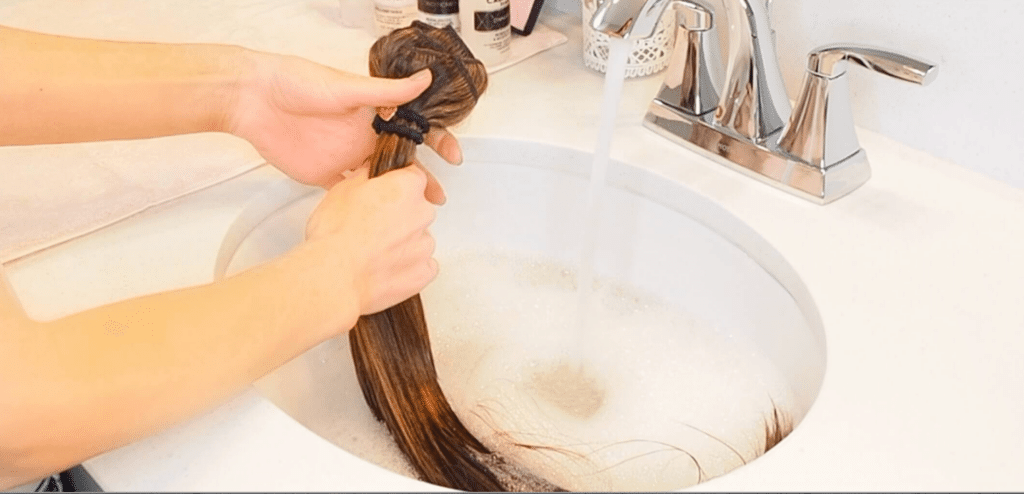
B) Installed sets — on-head clinical method
Common tools: extension brush, nozzle dryer, sulfate-free shampoo, light conditioner, sectioning clips.
General base-safe sequence (all installed methods):
1) Dry detangle: hold the row/bonds; brush ends → mid → base.
2) Pre-rinse: 1–2 minutes, cool-lukewarm, water flowing downward.
3) Scalp cleanse: emulsify a pea-size shampoo; apply to scalp lines and between rows with fingertips; straight motions only.
4) Pull-through cleanse: sweep lather down lengths. Do not rub seams, tapes, or bonds.
5) Rinse: lift rows slightly and let water run under tracks. Rinse until no film remains.
6) Condition mid-ends: keep 2–3 cm away from tapes, beads, seams, and keratin bonds.
7) Optional mask weekly: mid-ends only, 5–10 minutes.
8) Final cool rinse: close cuticle, increase shine.
9) Towel-press: no turban wrap; press in downward strokes.
10) Leave-in + heat protectant: lengths only.
11) Dry the base 100%: blow-dry attachment areas first with a nozzle, medium heat; then lengths. Never leave bases damp.
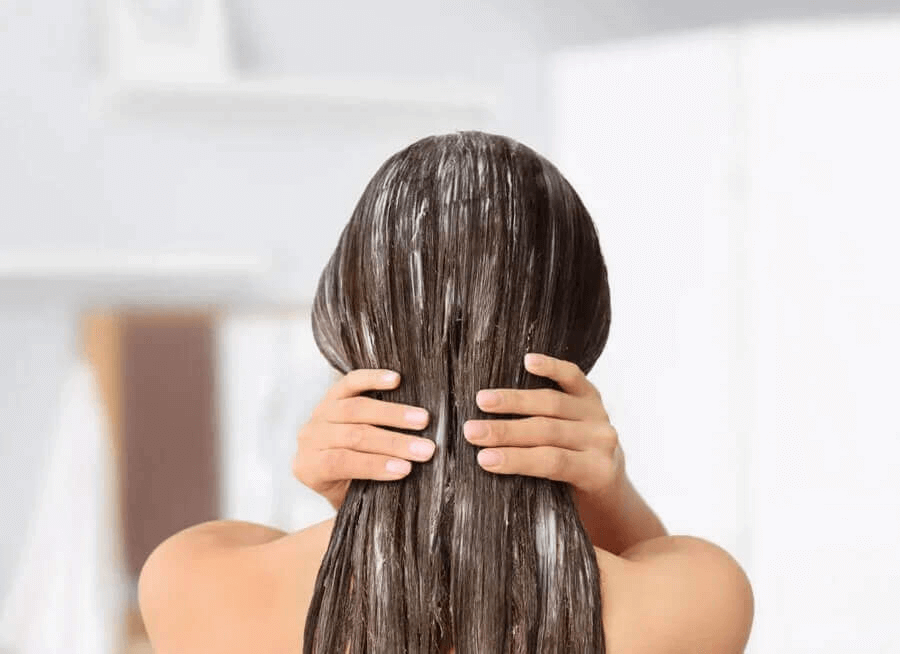
Now, method-specific add-ons:
Weft rows (hand-tied, machine, genius)
- Sectioning: create vertical “rails” between rows; drop one rail at a time to access scalp.
- Scalp focus: clean under the track by gently lifting the row with fingertips; never snag the stitch.
- Drying: point the nozzle along the row to seal the seam; check beads and stitches with fingertips for dryness.
- Do not saturate seams with masks; avoid heavy dry shampoo buildup at stitch line.
Tape-ins
- Keep oils, masks, and conditioners away from the sandwich edge.
- Clean part lines with fingertip pads, not nails.
- After rinsing, pinch each tape sandwich in a towel to extract water; then blow-dry the tape area first.
- Avoid hot tool passes directly on tape edges.
Keratin/fusion (U-tip, flat-tip, V-tip)
- Clean scalp lines between bonds; never knead bonds.
- Keep heat off bonds; if bonds feel soft, you used too much heat or product at the root.
- While blow-drying, pinch bonds lightly between fingers to keep shape and alignment.
I-tip/Nano
- Clean channels between beads with fingertip pads.
- Avoid pulling beads when detangling.
- Dry bead zones fully; check for any residual dampness by touch.
Curly/Wavy textures
- Emulsify shampoo fully before application.
- Detangle with fingers in the shower from mid-ends down.
- Condition generous mid-ends; scrunch in water to set pattern.
- Diffuse roots/rows 100% dry; then air-dry ends or diffuse on low.
How often can you wash hair extensions?
Over-washing dries fiber and shortens life. Under-washing causes itch, odor, and slip. Set a cadence by attachment, hair grade, and lifestyle.
Installed sets: wash 1–2× weekly. Temporary sets: wash after 3–6 wears. Rinse sweat and dry the base on training days.
Hair grade adjustments:
- Non-Remy: favor 1 weekly; richer rinse-out on ends; add leave-in.
- Remy: 1–2× weekly; weekly mask.
- Full cuticle: 2× weekly typical; weekly mask; best longevity.
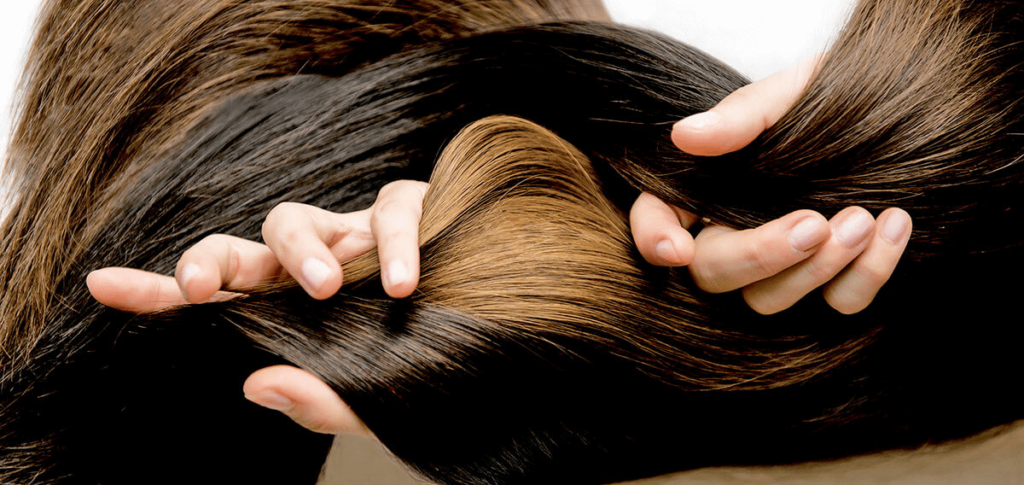
Can you wash hair extensions with normal shampoo?
“Normal” often means strong sulfates and heavy silicones. Those strip or deposit, then weaken attachment points.
Choose sulfate-free, low-residue shampoos (pH 5–6). Use lightweight conditioners on lengths only. Keep oils away from tapes and bonds. Clarify gently when minerals build up.
Prefer
- Gentle surfactants: sodium cocoyl isethionate, cocamidopropyl betaine.
- Chelators: disodium EDTA to fight hard water film.
- Light conditioning polymers: polyquaternium-7, panthenol, amino acids.
- Targeted silicones: amodimethicone (binds to damaged ends; low buildup).
Limit or avoid at the base
- SLS/SLES daily use (drying).
- Heavy oils/butters near tapes/bonds (slip).
- High alcohol leave-ins (dehydrate).
- Overuse of toning shampoos (cuticle roughness).
Special caution: sunscreens
Avobenzone and octocrylene can stain blonde extensions and may affect adhesives if migration occurs from neck/shoulders. Keep sunscreen off hair and tapes. Rinse hairline after sun.
What products help or harm during washing?
Clear product rules prevent most failures. The goal is clean scalp, smooth lengths, secure bases.
Use gentle cleanser, lightweight conditioner, weekly mask on ends, leave-in, and heat protectant. Avoid heavy residues at the base and bond-softening oils.
Build a safe wash kit
- Shampoo: sulfate-free, chelating-light, pH-balanced.
- Conditioner: slip without grease; mid-ends only.
- Mask: once weekly on lengths; ceramides, amino acids, argan esters.
- Detangler/leave-in: low alcohol, fine mist.
- Thermal shield: essential before every blow-dry and hot tool pass.
Known problems and fixes
- Sticky roots/tape slip: remove oils near base; switch to lighter leave-in; dry base longer.
- Gummy mid-ends: over-deposit of conditioners; clarify with gentle chelating shampoo; then mask.
- Dull blondes: mineral film from hard water; do a chelating wash; tone only if needed.
- Dry, crunchy ends: increase mask time on lengths; add a small amount of serum only from mid-ends down after drying.
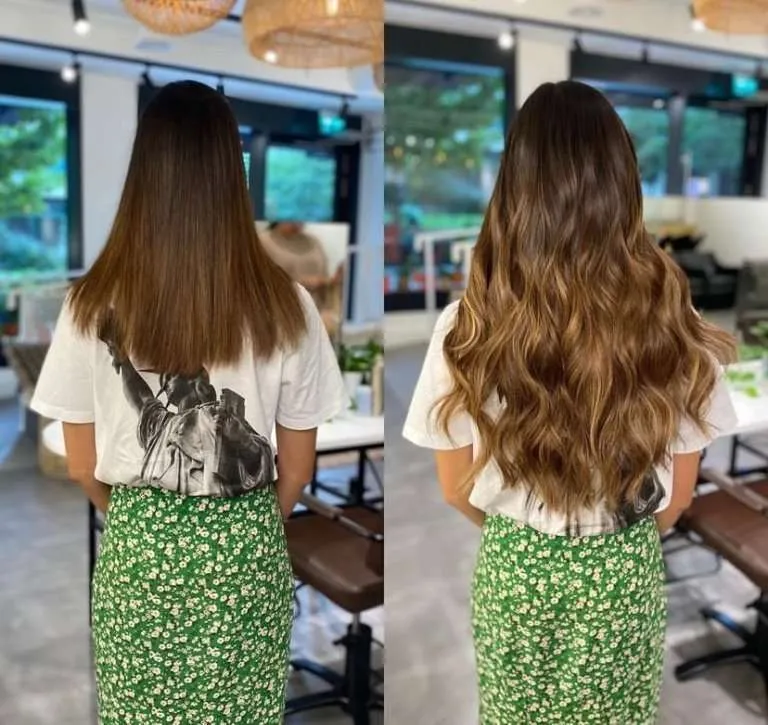
Water temperature, drying, and detangling rules
Heat and friction do most damage, not shampoo. Control both and you keep shine and strength.
Use cool-lukewarm water, never hot. Press instead of rubbing. Blow-dry attachment areas 100% every time. Brush ends to roots with support.
Temperature
Hot water swells the cuticle and accelerates color fade, especially on highlighted or double-processed lengths. Warm enough to cleanse is fine; finish cool to seal.
Drying protocol
Towel-press downward. Apply leave-in on lengths. Blow-dry the base first with a nozzle and medium heat until fully dry. Then dry lengths with a paddle brush. For curls, diffuse roots until dry; let ends finish on low or air.
Detangling discipline
Hold seams, beads, or bonds to reduce pull. Use a loop-bristle or boar-mix brush. Separate rows with fingers after drying. Sleep in a loose braid or two and use a silk/satin pillowcase.
Special situations: gym, swim, travel, and hard water
Life adds sweat, chlorine, salt, and minerals. You can handle each with small tweaks.
Rinse sweat, shield in pools, chelate in hard water zones, and carry a compact care kit for trips.
Gym and sweat
Rinse scalp lines with cool water after training. Dry the base 2–3 minutes with a dryer. Do a full wash if buildup or odor appears.

Swim protocol
Pre-wet with tap water. Smooth a pea-size conditioner on mid-ends. Wear a cap if possible. Rinse immediately after. Use a gentle chelating shampoo that day and a mask on ends.
Travel checklist
Extension brush, silk scrunchie, travel-size sulfate-free shampoo, light conditioner, leave-in, heat protectant, and a nozzle. Hotel water varies; do a chelating reset on return.
Hard water strategy
Signs: dullness, rough feel, blondes turning brassy. Use a chelating shampoo every 2–3 weeks, followed by a hydrating mask. Consider an in-salon clarifying service before a color gloss.
Troubleshooting: post-wash problems and quick fixes
Wash is done, but something feels off. Use this grid to diagnose fast and act before damage spreads.
| Symptom | Likely cause | Immediate fix | Prevention |
|---|---|---|---|
| Slipping tape edges | Oils/conditioner near tape; damp base | Clean and reinstall with fresh tape | Keep oils off base; dry sandwiches first |
| Musty odor | Base left damp | Rewash; disinfect scalp lines; dry base 100% | Always dry base before lengths |
| Matted nape | Friction + sweat + water left in | Detangle with leave-in; dry fully | Braid at night; rinse sweat; detangle daily |
| Crunchy ends | Heat without protectant; over-toning | Trim ends; add mask; use protectant | Protect before heat; limit toning shampoos |
| Itchy scalp | Product film or under-washing | Gentle chelating cleanse | Rinse sweat; keep schedule |
| Dull blonde | Mineral film | Chelate; gloss/toner if needed | Regular chelation in hard water |
| Fluffy frizz | Hot water; rough towel | Rewash ends; cool rinse; press-dry | Cool-lukewarm; microfiber towels |
My opinion
Strong installs fail when wash education is weak. The winning setup is simple: detangle dry, cleanse scalp in straight motions, condition lengths only, and dry the base first every time. Keep ingredients light and pH-balanced. Add a chelating step in hard water zones. When teams coach clients on these rules at pickup, longevity increases and after-care tickets drop.
FAQ
1) Can you wash extensions the same day as installation?
Yes. Use a gentle cleanse if needed, but most stylists suggest waiting 24–48 hours for tape adhesive to reach full strength.
2) How long after tape-in installation can you wash?
Ideally 24–48 hours. If you must wash sooner, keep it brief, avoid conditioner near tapes, and dry the sandwiches completely.
3) Do you wash extensions before color services?
Yes. Clarify gently 24–48 hours before toning or glossing. Remove mineral film so color grabs evenly.
4) What’s the best post-wash storage for clip-ins?
Fully dry, brushed, and stored flat in a breathable bag or hanging sleeve.
5) What water temperature is best?
Cool-to-lukewarm for cleansing; cool for final rinse. Avoid hot water.
6) How do you wash curly extensions?
Detangle with fingers, emulsify shampoo, cleanse scalp lines, condition mid-ends, scrunch in water, diffuse roots 100% dry.
7) Can sunscreen affect washing outcomes?
Yes. Avobenzone and octocrylene can stain blondes and migrate to adhesives. Keep off hair; rinse hairline after use.
8) Can you co-wash installed extensions?
Not as the only method. Co-wash leaves film at the base. Alternate with a gentle shampoo to keep the scalp clean.
9) Do you need a different routine for full cuticle hair?
The steps are the same, but full cuticle hair tolerates washing better. Keep base protection strict to maximize life.
10) Do oils belong in a wash routine?
Light oils only on mid-ends after drying. Never near tapes, beads, stitches, or bonds.
11) What if tapes turn white or gooey after washing?
They were exposed to oils/conditioners or stayed damp. Replace tapes, reset product use, and dry the base first.
12) How do you prevent odor in rows?
Clean scalp lines well and dry the track fully. Never air-dry rows at the base.
13) Which brush is best around wash days?
Loop-bristle or boar/nylon mix. Support row/bonds with the other hand.
14) How long should a proper wash take on installed sets?
About 15–25 minutes including full base drying. Never rush the drying step.
15) Can you sleep with damp hair after washing?
No. Always dry attachment areas 100% before bed.
16) How do you wash wefts with sensitive scalps?
Use a mild, fragrance-light shampoo. Work in straight lines. Rinse cool and keep products away from the seam.
17) How do you fix post-wash tangles fast?
Mist a leave-in, divide into small panels, brush ends upward. Dry completely to lock in smoothness.
18) What about hard water homes?
Plan a chelating wash every 2–3 weeks. Consider a shower filter. Follow with a mask.

Conclusion
Detangle dry, cleanse scalp in straight lines, condition lengths only, and dry the base first. Match steps to the attachment. Keep products light and pH-balanced for lasting, glossy results.
where to buy best quality hair extensions
Hibiscus Hair Manufacturer has been dedicated to producing high-quality hair extensions for 25 years and is a recognized leader in the industry. If you are interested in finding a reliable hair extensions supplier and wholesale for your brand, please visit our website for more information:
HOME

